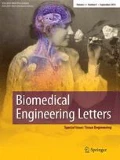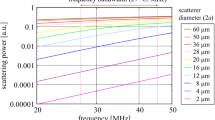Abstract
The purpose of this study is to investigate a spectrum analysis technique for detecting and monitoring red blood cell (RBC) aggregation using a high-frequency array transducer. To assess the feasibility of this approach, the backscattered radio-frequency signal from non-aggregated and aggregated RBC samples with two hematocrit levels were acquired by using a 30-MHz linear array transducer and analyzed in frequency domain. Three parameters such as spectral slope, midband fit and Y intercept were extracted in a static condition. Fresh porcine blood was used and degrees of aggregation were changed by diluting plasma concentration. From the experiments, it was demonstrated that the spectral slope related to a size of scatterer progressively declined as the level of aggregation increased; its mean values at hematocrit of 40% were 1.10 and −0.22 dB/MHz for RBCs suspended in isotonic phosphate buffered saline and solution with 70% plasma concentrations, respectively. For the midband fit and Y intercept, the mean values were increased by 9.1 and 46.4 dB, respectively. These results indicated that the spectrum analysis technique is useful for monitoring RBC aggregation and can be potentially developed for assessing aggregation in clinical applications.







Similar content being viewed by others
References
Meiselman HJ. Red blood cell aggregation: 45 years being curious. Biorheology. 2009;46:1–9.
Mchedlishvili G, Gobejishvili L, Beritashvili N. Effect of intensified red blood cell aggregability on arterial pressure and mesenteric microcirculation. Microvasc Res. 1993;45:233–42.
Rampling MW. Haemorheology and the inflammatory process. Clin. Hemorheol Microcirc. 1998;19:129–32.
Baskurt OK, Neu B, Meiselman HJ. Red blood cell aggregation. Boca Raton, FL: CRC Press; 2011. p. 1–304.
Baskurt OK, Uyuklu M, Hardeman MR, Meiselman HJ. Photometric measurements of red blood cell aggregation: light transmission versus light reflectance. J Biomed Opt. 2009;14:054044.
Lee SJ, Ha H, Nam K-H. Measurement of red blood cell aggregation using X-ray phase contrast imaging. Opt Express. 2010;18:26052–61.
Hysi E, Saha RK, Kolios MC. Photoacoustic ultrasound spectroscopy for assessing red blood cell aggregation and oxygenation. J Biomed Opt. 2012;17:125006.
Shehada REN, Cobbold RSC, Mo LYL. Aggregation effects in whole blood: influence of time and shear rate measured using ultrasound. Biorheology. 1994;31:115–35.
Yuan YW, Shung KK. Ultrasonic backscatter from flowing whole blood. II. Dependence on frequency and fibrinogen concentration. J Acoust Soc Am. 1988;84:1195–200.
Sennaoui A, Boynard M, Pautou C. Characterization of red blood cell aggregate formation using an analytical model of the ultrasonic backscattering coefficient. IEEE Trans Biomed Eng. 1997;44:585–91.
Fontaine I, Bertrand M, Cloutier G. A system-based approach to modeling the ultrasound signal backscattered by red blood cells. Biophys J. 1999;77:2387–99.
Kirk Shung K, Fei D, Yuan Y, Reeves WC. Ultrasonic characterization of blood during coagulation. J Clin Ultrasound. 1984;12:147–53.
Huang CC, Wang SH, Tsui PH. Detection of blood coagulation and clot formation using quantitative ultrasonic parameters. Ultrasound Med Biol. 2005;31:1567–73.
Cloutier G, Qin Z. Shear rate dependence of ultrasound backscattering from blood samples characterized by different levels of erythrocyte aggregation. Ann Biomed Eng. 2000;28:399–407.
Huang CC, Tsui PH, Wang SH. Detection of coagulating blood under steady flow by statistical analysis of backscattered signals. IEEE Trans. Ultrason., Ferroelect., Freq. Contr. 2001; 54:435–42.
Nam K-H, Yeom E, Ha H, Lee SJ. Simultaneous measurement of red blood cell aggregation and whole blood coagulation using high-frequency ultrasound. Ultrasound Med Biol. 2012;38:468–75.
Lizzi FL, Greenebaum M, Feleppa EJ, Elbaum M, Coleman DJ. Theoretical framework for spectrum analysis in ultrasonic tissue characterization. J Acoust Soc Am. 1983;73:1366–73.
Lizzi FL, Feleppa EJ, Alam SK, Deng CX. Ultrasonic spectrum analysis for tissue evaluation. Pattern Recogn Lett. 2003;24:637–58.
Tateishi T, Machi J, Feleppa EJ, Oishi R, Jucha J, Yanagihara E, McCarthy LJ, Noritomi T, Shirouzu K. In vitro diagnosis of axillary lymph node metastases in breast cancer by spectrum analysis of radio frequency echo signals. Ultrasound Med Biol. 1998;24:1151–9.
Feleppa EJ, Porter CR, Ketterling J, Lee P, Dasgupta S, Urban S, Kalisz A. Recent developments in tissue-type imaging (TTI) for planning and monitoring treatment of prostate cancer. Ultrason Imaging. 2004;26:163–72.
Kolios MC, Czarnota GJ, Lee M, Hunt JW, Sherar MD. Ultrasonic spectral parameter characterization of apoptosis. Ultrasound Med Biol. 2002;28:589–97.
Padilla F, Akrout L, Kolta S, Latremouille C, Roux C, Laugier P. In vitro ultrasound measurement at the human femur. Calcif Tissue Int. 2004;75:421–30.
Silverman RH, Rondeau MJ, Lizzi FL, Coleman DJ. Three-dimensional high-frequency ultrasonic parameter imaging of anterior segment pathology. Ophthalmology. 1995;102:837–43.
Yamaguchi T, Hachiya H. Proposal of a parametric imaging method for quantitative diagnosis of liver fibrosis. J. Med. Ultrason. 2010;37:155–66.
Lee C, Jung H, Lam KH, Yoon C, Shung KK. Ultrasonics scattering measurements of a live single cell at 86 MHz. IEEE Trans Ultrason Ferroelectr Freq Control. 2015;62:1968–78.
Cannata JM, Williams JA, Hu CH, Shung KK. A high-frequency linear ultrasonic array utilizing an interdigitally bonded 2-2 piezo-composite. IEEE Trans Ultrason Ferroelectr Freq Control. 2011;58:2202–12.
Mo LY, Kuo IY, Shung KK, Ceresne L, Cobbold RS. Ultrasound scattering from blood with hematocrits up to 100%. IEEE Trans Biomed Eng. 1994;41:91–5.
Acknowledgements
This work was supported by the National Research Foundation of Korea (NRF) grant funded by the Korea government (MSIP; Ministry of Science, ICT & Future Planning) (No. 2017R1C1B5016846).
Author information
Authors and Affiliations
Corresponding author
Rights and permissions
About this article
Cite this article
Yoon, C. Spectrum analysis for assessing red blood cell aggregation using high-frequency ultrasound array transducer. Biomed. Eng. Lett. 7, 273–279 (2017). https://doi.org/10.1007/s13534-017-0034-3
Received:
Revised:
Accepted:
Published:
Issue Date:
DOI: https://doi.org/10.1007/s13534-017-0034-3




